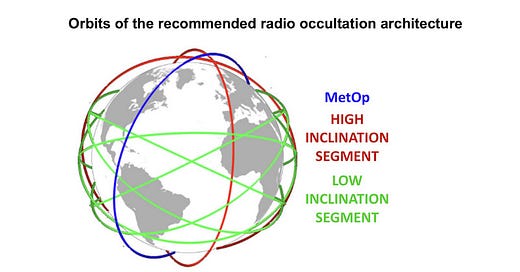NOAA’s Commercial Data Program Announces Radio Occultation Objectives
Plans to Procure Commercial RO Data-As-a-Service From Diverse and Coordinated Orbits
In January, NOAA/NESDIS completed a Phase 1 of the Radio Occultation (RO) Analysis of Alternatives (AoA) for the Office of Space Commerce to assess constellation concepts for Global Navigation Satellite System (GNSS) RO capabilities, as the set of six COSMIC-2 satellites reach the end of their operational life.
The findings highlight the need for a sufficient number of well-distributed GNSS-RO observations, along with enhancement in data refresh rates and reduced latency.
To effectively address these needs, NOAA plans to procure commercial RO data-as-a-service from diverse and coordinated orbits. Observations within the equatorial regions are especially important for improving latency and data refresh into weather prediction models.
According to the study, a baseline constellation consisting of COSMIC-2 and existing international partner missions initially meets the daily profile criteria. However, the loss of five COSMIC-2 spacecraft, estimated by 2035, leads to insufficient tropical and mid-latitude coverage. Augmenting the baseline constellation with an additional 4,000 profiles per day from current CDaaS providers allows daily count criteria to be met throughout the assessed period. However, even with this augmentation, the system does not meet the six-hour global refresh requirement.
Notably, the six-hour refresh criteria is met in the tropics when the baseline constellation is supplemented with commercial data, largely due to COSMIC-2’s design, which includes six satellites in low-inclination/equatorial orbits. Polar-orbiting satellites alone cannot efficiently provide adequate coverage in the tropics and mid-latitudes. To fully satisfy the refresh requirement, existing international partner missions must be supplemented by an additional six satellites in low-inclination orbit (similar to COSMIC-2) and two in high-inclination, sun-synchronous orbits are required.
NOAA will seek to increase RO commercial data acquisitions in the equatorial regions as COSMIC-2 degrades in addition to increasing RO commercial data purchases in the polar and mid-latitude regions.
Focusing on diverse orbits with appropriate data latency will ensure continuous global geographic coverage and consistent local observation times, supporting NOAA’s weather modeling and space weather applications.
NOAA plans to align with the Radio Occultation Modeling Experiment (ROMEX) study, which analyzes the impact of radio occultation data on forecasting and recommends a minimum of 20K RO profiles/day.





